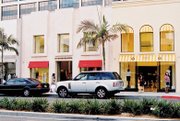Top Designers Revive Rodeo Drive
There’s a land rush on Rodeo Drive.
Iconic designers and retailers—ranging from Prada and Michael Kors to BCBG Max Azria—will spend much of 2004 either moving to Rodeo Drive or expanding their current stores at Beverly Hills’ top address for high-end retail.
The flurry of real estate activity on the 300 and 400 blocks of North Rodeo Drive is confirmation that the luxury market has continued to grow since Christmas 2003 marked a spike in consumer interest in luxury goods, said Wendy Krueger, director of sales for Luxe Hotel Rodeo Drive, which neighbors many of the street’s new tenants.
“People are spending money again,” Krueger said, anticipating the crowds flocking to the new stores. “It’s going to be good to see new designers.”
One of the most highly anticipated additions to the street will be the new Prada flagship store at 343 N. Rodeo Drive. Rem Koolhaas, who designed Prada’s $40 million flagship store in Manhattan, will design the three-story, 21,000-square-foot store.
Michael Kors recently signed a lease for a 3,000-squarefoot space at 360 N. Beverly Drive, the former site of Valentino. The transaction was brokered by Chuck Dembo of Beverly Hills–based Dembo & Associates. Dembo also was the realtor who brought the Roberto Cavalli store to the 3,000- square-foot space at 362 N. Rodeo Drive.
BCBG Max Azria, which has done business at 315 N. Rodeo Drive for three years, will move to a 5,000-square-foot space at 443 N. Rodeo Drive. New York–based luxury accessories brand Coach is expected to move into BCBG’s old space, according to representatives from the city of Beverly Hills and real estate brokerages, but a spokeswoman from Coach said it was too early to discuss the store.
Italian clothing retailer Etro will open a store this summer at 461 N. Rodeo Drive. Vilebrequin, a men’s swimwear shop, will open at 2 Rodeo Drive.
Other stores will refresh their look by expanding their size. Louis Vuitton will add a third floor to its building at 295 N. Rodeo Drive, and Dolce & Gabbana will double its store size at 312 N. Rodeo Drive by leasing an adjacent storefront.
Premium address
Space comes at a premium on Rodeo, where rents average $300 per square foot. Several blocks away on Beverly Boulevard, rents average $96 per square foot, according to Dembo.
However, having a presence on Rodeo is well worth the price tag, said Danny Moizel, senior vice president of real estate for BCBG Max Azria.
“From a branding standpoint, we’re on every major street in most metropolitan cities,” Moizel said. “It’s important to be located on those streets because our consumer is there.”
Rodeo redux
But even Rodeo Drive experiences hard times. After the Sept. 11 terrorist attacks, the street’s sales revenue dropped from $262.5 million in the 2000–2001 fiscal year to $244.8 million in the 2001–2002 fiscal year, according to the city of Beverly Hills. Sales recovered in the 2002–2003 fiscal year, reaching $259.1 million.
Luxury retailers were particularly affected by the global economic slowdown after Sept. 11, according to Richard Giss, a retail analyst with the Los Angeles offices of Deloitte.
“It didn’t feel right to do recreational shopping after Sept. 11,” Giss said of American consumers’ emotional state after the attacks. “Because so much of Rodeo Drive is based on tourism, it hurt that street disproportionately to other areas when tourism fell.”
Tourism has been on the rebound, according to the Beverly Hills Visitors and Conference Bureau. More than 84 percent of the city’s hotel rooms were filled in February 2004, compared with 65 percent in February 2003. City and commercial groups have also been taking steps to continue making Rodeo Drive a must-see stop for foreign and domestic tourists.
The Rodeo Drive Committee, a merchants association, unveiled the Rodeo Drive Walk of Style in 2003. The walk honors titans of the fashion industry with street plaques, much as Hollywood’s Walk of Fame honors movie stars. In September 2003, Giorgio Armani became the first designer inducted into the Walk of Style. Tom Ford was inducted in March 2004.
The city of Beverly Hills is in the midst of completing an $18 million street improvements program for Beverly and Canon boulevards, Dayton and Brighton ways, and Rodeo Drive.
To make the street more pedestrian-friendly, the city widened Rodeo’s sidewalks by 18.5 feet and added streetlights and king palm trees to the sidewalks in late 2003.
Giss said the improvements should add to the street’s reputation.
“One thing doesn’t change,” Giss said. “If you’re going to talk about an upscale shopping area, the first thing you think of is Rodeo Drive, and you’re not going to be disappointed. You’re going to see all of the big names there.”






















